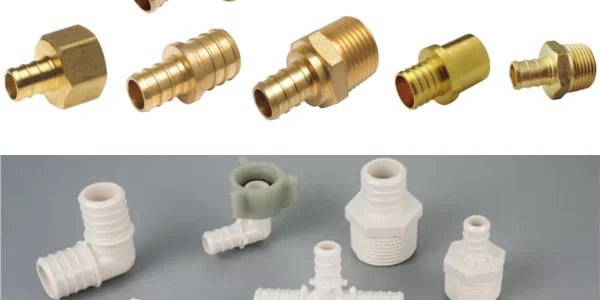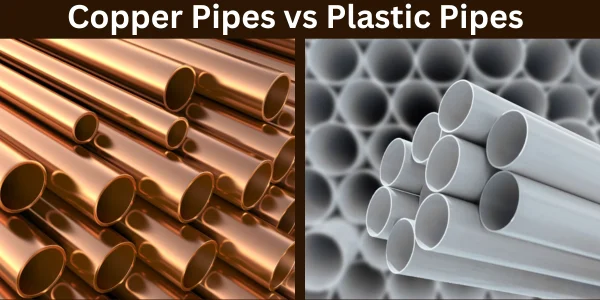When it comes to PEX (cross-linked polyethylene) plumbing systems, choosing the right type of fitting is crucial for ensuring durability, performance, and long-term reliability. Two popular options are plastic PEX fittings and brass PEX fittings. Each has its own advantages and disadvantages, making the choice dependent on various factors such as budget, water quality, and installation needs.
In this article, we’ll compare plastic vs brass PEX fittings in terms of durability, cost, corrosion resistance, and ease of installation to help you make the right choice for your plumbing system.
What Are PEX Fittings?
PEX fittings are connectors used to join PEX pipes securely. These fittings come in two main materials: plastic and brass. Both are designed to work with crimp rings, clamp rings, or push-fit systems, ensuring a leak-free plumbing connection.
Key Differences Between Plastic and Brass PEX Fittings

a) Material Composition
- Plastic PEX Fittings: Made from high-strength polymer materials such as polyphenylsulfone (PPSU). These fittings are lightweight yet durable.
- Brass PEX Fittings: Made from solid brass, offering a sturdy and robust construction. Brass fittings are heavier and stronger than plastic alternatives.
b) Durability and Strength
- Plastic PEX Fittings: Highly resistant to cracking, scaling, and chemical reactions. They perform well under consistent water pressure but may not be as strong as brass under extreme stress.
- Brass PEX Fittings: Known for their superior strength and durability, brass fittings are ideal for high-pressure plumbing systems.
Winner: Brass for strength; Plastic for chemical resistance.
c) Corrosion Resistance
- Plastic PEX Fittings: Completely resistant to corrosion, rust, and mineral buildup. This makes them ideal for areas with hard or aggressive water conditions.
- Brass PEX Fittings: While durable, brass can corrode over time, especially in areas with acidic or high-chlorine water.
Winner: Plastic for superior corrosion resistance.
d) Cost
- Plastic PEX Fittings: More affordable than brass, making them a budget-friendly option for homeowners and contractors.
- Brass PEX Fittings: Generally more expensive due to the higher material cost.
Winner: Plastic for affordability.
e) Ease of Installation
- Plastic PEX Fittings: Easier to cut, lightweight, and simple to maneuver in tight spaces.
- Brass PEX Fittings: While durable, brass fittings can be heavier and require more effort to install.
Winner: Plastic for convenience in tight spaces; Brass for strength in demanding conditions.
f) Temperature Tolerance
- Plastic PEX Fittings: Suitable for standard residential water temperatures but may weaken under extreme heat.
- Brass PEX Fittings: Better suited for high-temperature applications, such as hot water systems.
Winner: Brass for high-temperature applications.
g) Environmental Impact
- Plastic PEX Fittings: Manufactured from synthetic materials, but often recyclable depending on local facilities.
- Brass PEX Fittings: More environmentally friendly as brass is recyclable and can be repurposed.
Winner: Brass for eco-friendliness.
Pros and Cons of Plastic PEX Fittings
Pros
✅ Affordable and cost-effective
✅ Lightweight and easy to handle
✅ Excellent resistance to corrosion
✅ Ideal for aggressive water conditions
✅ Quick installation process
Cons
❌ May crack under excessive pressure
❌ Limited durability in extreme heat
❌ Less durable than brass fittings in high-stress environments
Pros and Cons of Brass PEX Fittings
Pros
✅ Stronger and more durable under high pressure
✅ Suitable for both hot and cold water systems
✅ Ideal for long-term use in demanding conditions
✅ Recyclable and environmentally friendly
Cons
❌ More expensive than plastic fittings
❌ Prone to corrosion in certain water conditions
❌ Heavier and may require extra effort during installation
When to Use Plastic vs Brass PEX Fittings?
Choose Plastic PEX Fittings If:
✔️ You’re working on a tight budget
✔️ Your area has aggressive or acidic water
✔️ You need an easy-to-install solution for a DIY project
✔️ The system operates under standard residential water pressure
Choose Brass PEX Fittings If:
✔️ You need a stronger option for high-pressure systems
✔️ The system handles hot water frequently
✔️ You’re looking for a long-term investment with better durability
✔️ You’re working in commercial plumbing projects
Conclusion: Which One is Better for Plumbing?
Both plastic and brass PEX fittings have their unique strengths. If you’re looking for an affordable, corrosion-resistant, and easy-to-install solution, plastic PEX fittings are a great choice. On the other hand, if you need durability, strength, and heat resistance, brass PEX fittings are a more suitable option.
For residential plumbing with standard water pressure, plastic fittings are often sufficient. For commercial or high-pressure systems, brass fittings may offer better long-term performance.
Pro Tip: When choosing between the two, consider your water quality, budget, and plumbing demands to make the best decision for your home or project.
If you need expert plumbing advice or installation services, consult with a licensed plumber to ensure the best results.

